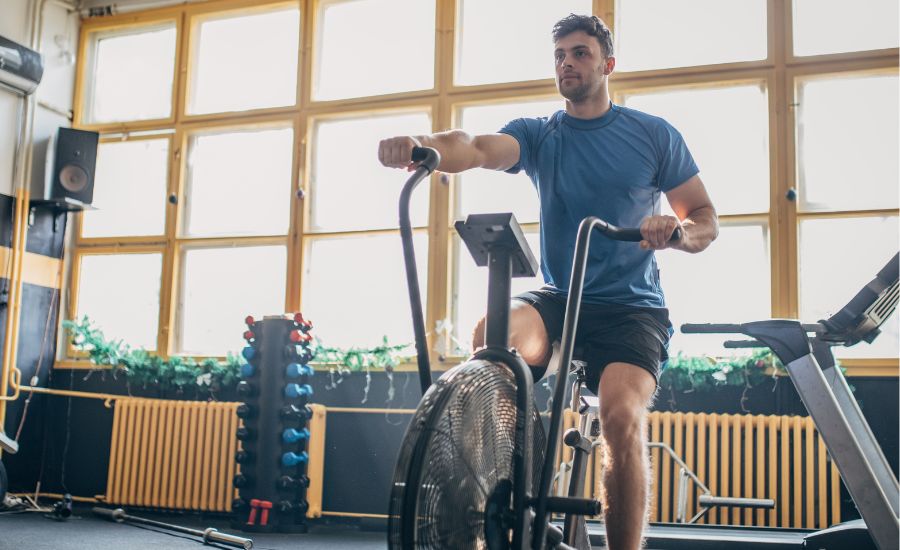In the pursuit of weight loss, many individuals turn to various forms of exercise to achieve their goals. One popular option is the exercise bike, a stationary cycling machine that offers a low-impact cardiovascular workout.
The question arises: does an exercise bike truly help lose weight? In this article, we will delve into the effectiveness of using exercise bikes or stationary bikes as weight-loss tools, exploring their benefits, considerations, and potential drawbacks.

Benefits of using exercise bikes (stationary bikes) for losing weight
Are exercise bikes good for weight loss? Regular aerobic exercise is known to be good for weight loss by burning calories and improving overall fitness levels. An exercise bike can provide several advantages in this regard:
Low-impact workout: upright bike and recumbent one
One of the key benefits of using an exercise bike, whether it’s an upright bike or recumbent bike, is that it offers a low-impact workout, reducing stress on the joints compared to activities such as running or high-impact aerobics. This stationary bike workout makes it an excellent choice for individuals with joint issues or those who are overweight.

Burning calories
Riding exercise bikes can be an effective way to burn more calories.
The number of calories burned depends on various factors such as the intensity of the workout, the duration, and the individual’s weight.
Generally, the more intense and longer the workout, the more calories you’ll burn. How many calories you will lose? On average, a 30-minute session on an exercise bike can burn between 200-300 calories, but this can vary.
Cardiovascular health
A regular cardio workout, such as indoor cycling on an exercise bike or using cardio fitness exercise bikes, can improve heart health by strengthening the heart muscle and increasing overall cardiovascular fitness.
This can have long-term benefits for losing weight and overall well-being.
Convenience and accessibility
Exercise bikes or stationary bikes offer the advantage of convenience and accessibility.
They can be used in the comfort of one’s home for indoor cycling, eliminating the need to commute to a gym or exercise facility. This accessibility promotes consistency and adherence to a regular exercise routine, allowing you to burn more calories over time.

Considerations when using an exercise bike
While people question themselves are exercise bikes good for weight loss, it is essential to consider a few factors to maximize their benefits:
Intensity and duration
The intensity and duration of your cardio workout on the exercise bike play a crucial role in weight loss. Gradually increase the intensity and duration as your fitness level improves.
To burn more calories, aim for moderate moderate-intensity exercise to high-intensity workouts lasting at least 30 minutes or longer. The longer and more intense workout will affect how many calories you’ll likely burn, aiding in your efforts.
Variety and progression
To prevent boredom and plateauing, incorporate variety into your stationary bike workouts.
Mix up the resistance levels, use different workout programs, or try high-intensity interval training to challenge your upper and lower body and keep it guessing. Continual progression is key to achieving goals.
Proper form
Maintaining proper form while cycling on an exercise bike is important to prevent injuries and maximize the effectiveness of your workout.
Keep your back straight, and shoulders relaxed, and engage your core muscles throughout the workout.
Focusing on form ensures that you are using the correct muscles and getting the most out of your exercise session.

Balanced approach
While people question themselves if using indoor exercise bikes good for weight loss, it should be combined with a balanced approach that includes a healthy diet and other forms of exercise to lose more calories.
Incorporating strength training exercises alongside cycling can help build muscle, which in turn increases metabolism and enhances efforts.
Nutrition. Weight loss is not solely dependent on exercise; nutrition plays a critical role. To create a deficit necessary it is important to consume a balanced diet that includes a variety of nutrient-dense foods. Focus on whole grains, lean proteins, fruits, vegetables, and healthy fats.
Monitor your calorie intake and ensure it aligns with your goals. Consulting with a registered dietitian or nutritionist can provide personalized guidance and support.
Strength training. While riding a stationary bike primarily engages the lower body muscles, incorporating strength training exercises can aid in efforts.
Strength training helps build lean muscle mass, which boosts metabolism and increases the number of calories burned at rest. Exercises that target all major muscle groups, such as squats, lunges, push-ups, and planks, can contribute to overall fat loss and enhance body composition.
Lifestyle habits. Sustainable weight loss is not only about exercise and nutrition but also encompasses lifestyle habits.
Prioritize adequate sleep, manage stress levels, and stay hydrated. These factors can influence your body’s ability to lose weight effectively and maintain overall health.
Track your workouts. Keep a record of your exercise sessions, noting the duration, intensity, and resistance level used.
This helps you monitor your progress over time and identify patterns or trends. Additionally, tracking your workouts can provide motivation and a sense of accomplishment as you see your efforts paying off.
Measure body. Instead of solely relying on the scale, consider measuring your body composition to get a more comprehensive understanding of your progress.
This can be done through methods such as body measurements (waist, hips, etc.) or using tools like body fat calipers or bioelectrical impedance scales.
Listen to your body. Pay attention to how your body feels during and after your stationary bike workouts. If you’re experiencing pain or discomfort, it’s important to address it and make necessary adjustments.

Potential drawbacks of exercise bikes
While exercising burns calories, good for weight loss, and has numerous benefits, it is important to be aware of the potential drawbacks of using a stationary exercise bike.
Limited muscle engagement
Cycling primarily engages the lower body muscles, particularly the quadriceps, hamstrings, and glutes.
While this can contribute to toning and strengthening these muscle groups, it may not provide a comprehensive full-body workout. To achieve overall strength and muscle balance, incorporating other exercises into your routine is advisable.
Lack of weight-bearing exercise: not only body weight
Unlike activities such as running or walking, cycling on indoor exercise bikes does not involve weight-bearing on the joints — only body weight.
While this can be advantageous for individuals with joint issues, it may not provide the same bone-strengthening benefits as weight-bearing exercises.
To maintain bone health, it is important to incorporate weight-bearing exercises into your overall fitness regimen.

Motivation and boredom
Some individuals may find cycling on an exercise bike monotonous or lack the motivation to maintain a consistent routine. To combat this, try listening to music or audiobooks, watching TV shows or movies, or joining virtual cycling classes to make your workouts more engaging and enjoyable.
Plateau effect. Over time, the body may adapt to the exercise bike routine, leading to a plateau in weight loss progress. To overcome this, it is crucial to continually challenge your body with varied workouts, increased intensity, and progressive training methods.
Muscle imbalance. Cycling primarily targets the muscles, neglecting the upper body and core. Over time, this can lead to muscle imbalances and posture issues.
To address this, consider incorporating exercises that target the upper body and core muscles, such as weightlifting or bodyweight exercises, into your fitness routine.
Sustainability and motivation. Some individuals may find riding a stationary bike monotonous or struggle with maintaining motivation in the long term. To combat this, find ways to make your workouts enjoyable and engaging.
Listen to music, podcasts, or audiobooks, watch TV shows or movies, or join virtual cycling classes.
Additionally, mix up your exercise routine by incorporating outdoor cycling, group fitness classes, or other forms of cardio exercises to keep things interesting.

FAQ
Here are some popular questions.
Can you lose belly fat by riding a stationary bike?
Yes, riding a bike can contribute to losing body fat and belly fat in particular.
When you engage in cardiovascular exercise like cycling, you burn more calories and create a calorie deficit, which can lead to overall weight loss and a reduction in belly fat.
Consult with healthcare professionals or fitness experts to create a personalized plan that aligns with your goals and needs.
How long should you ride a stationary bike to lose weight?
The duration of riding a stationary bike to lose weight can vary depending on factors such as your fitness level, intensity, and overall weight loss goals.
Generally, it is recommended to aim for at least 150 minutes of moderate-intensity cardiovascular exercise with a stationary bike, such as cycling, per week for weight loss.
This can be divided into 30 minutes per day, five days a week, or adjusted based on your schedule and preferences. It’s important to gradually increase the duration and intensity of your workouts as your fitness level improves.
Is 30 minutes a day on an exercise bike enough to lose weight?
Engaging in 30 minutes of exercise on an exercise bike per day can contribute to weight loss, especially when combined with a balanced weight-loss diet and a healthy lifestyle.
It’s important to note that the rate of weight loss varies among individuals, and factors such as overall calorie intake, intensity of exercise, and body composition play a role.
To optimize weight loss and burn more calories, it may be beneficial to gradually increase the duration and intensity of your exercise bike workouts over time.
Consulting with a healthcare professional or a certified fitness trainer can help you establish a personalized exercise plan based on your specific goals and needs.
Can you lose weight just by riding a stationary bike?
Yes, riding a stationary bike can contribute to weight loss.
When you engage in regular cardiovascular exercise like cycling, you burn calories, which can create a calorie deficit necessary for weight loss. However, weight loss is a complex process that involves various factors, including diet, overall calorie balance, and individual metabolism.
To achieve sustainable weight loss, it is important to adopt a holistic approach that includes a balanced diet, regular exercise with a stationary bike, and healthy lifestyle habits.
Incorporating strength training exercises alongside cycling with a stationary bike can also help build muscle, increase metabolism, and enhance weight loss efforts.
Conclusion
In conclusion, an exercise bike can be a valuable tool in a weight loss journey. Its low-impact nature, calorie-burning potential, and cardiovascular benefits make it an appealing choice for individuals of various fitness levels.
However, it is important to consider the intensity and duration of workouts, incorporate variety and progression, maintain proper form and healthy diet, and adopt a balanced approach to maximize weight loss results.
By being aware of the potential drawbacks and addressing them through a well-rounded fitness regimen, exercise bikes can contribute to achieving weight loss goals and improving overall health and fitness.

